Why Connect More Than One Battery To An RV?
An RV uses more electricity than you think. RVers usually figure this out pretty quick when they try out boondocking or dry camping without electrical hookups.
Every time you turn on a light, use the water pump, a fan, or the furnace, power is being drained from the batteries.
Even when switched over to LP gas (propane) the fridge is using electricity.
Related Product: We use the reliable VMAX 100Ah AGM battery (click to view on Amazon) in our RV.
No matter what kind of RV battery or batteries you are using, it’s not good to drain them completely.
Lead-acid batteries should only be discharged down to around 50% and Lithium-ion around 20%.
Any more than that will slowly damage the batteries and make them lose the ability to hold a full charge.
Even if you use a generator or solar panel to charge the RV batteries every day, you are going to want a lot of stored power.
That way, you can use as much electricity as you need between charging without damaging the RV batteries.
See Also: Best Deep Cycle RV Batteries (AGM, SLA, 12V, 6V)
One of the easiest ways to add more battery power to your camper is to add more RV batteries.
In this article, I’m going to show the best ways to wire both 12 volt and 6 volt batteries to an RV.
This is about adding 12 volt power to your RV, not creating a solar power bank.
My knowledge is very limited when it comes to large solar power banks that require a lot of batteries.
But, if you want to know more about RV batteries and how to wire them, you’ve come to the right place.
How To Correctly Wire Multiple 12 Volt Batteries To An RV
Wiring multiple 12V RV batteries to an RV isn’t very difficult and most people can do it themselves.
There are a few ways to do it wrong, and I’ll try to cover some common mistakes.
The goal is to wire the 12V batteries together in parallel correctly, so the power output and input is balanced between all the batteries.
This will make the RV batteries last longer and work better.
What You Will Need
The first thing you need to wire RV batteries together is the proper wire. The best sizes to use are 6-4 AWG copper wire.
I suggest 4 AWG because less resistance equals a more efficient transfer of power from battery to battery.
Because every set-up is going to be a little different, depending on the sizes of batteries used and the storage space, I suggest getting a long length of red and black 4 AWG copper wire with the right battery terminal connectors.
See Also: Best 12 Volt RV Lithium Battery Reviews + How To Charge
The Windy Nation 4 AWG Wire Kit (click to view on Amazon) is perfect for most deep cycle RV batteries and there should be enough wire for your average RV battery connections.
If you plan on connecting more than 4 RV batteries or there will be some distance between them, get more wire just in case.
For RV setups that will have a lot of power draw, like if you have a large inverter, you may want to go as high as 2 AWG wire to increase the capacity.
To do the job right, you will also need a crimping tool (click to view on Amazon).
You can try without it, but your terminal connections might not be as tight or secure, which could mean more resistance or a battery that isn’t connected.
What Is Parallel Wiring?
When you connect batteries through parallel, you are combining the positive terminals to the positive ones and the negative to negative.
This combines the batteries to create one large one that still has the same voltage.
You cannot combine batteries of different voltages. It’s also not recommended to combine different ages and sizes of batteries even though it is possible to do so with parallel wiring.
See Also: How Long Will An RV Battery Run The Furnace? + Calculations
I won’t go into the specifics of what parallel wiring is because that’s not really what this article is about.
You can read more about parallel and series wiring here if you want to learn more.
The main thing you need to know is that you parallel wire 12V batteries for RVs.
You want the voltage to stay the same unlike when you wire 6V batteries in series because, in that case, you want to double the voltage.
The Wrong Way To Parallel Connect 12 Volt Batteries
This way of parallel connecting 12V RV batteries technically works.
You can see in the graphic below that the positive terminals are connected and so are the negatives.

The wrong part is the load wires that connect the batteries to the RV are both placed on the same battery.
This setup draws most of the power from the first battery and the least amount of power from the battery furthest down the line.
If you parallel wire your RV batteries like this, the first batteries are going to wear out much faster than the others.
You want the load to be evenly distributed so all the batteries are charging and discharging equally.
See Also: NOCO Genius 5 Tested & Reviewed For Deep Cycle RV Batteries
The Best Way To Parallel Wire Multiple 12V Batteries
I’ve shown you the worst way. Now I’ll talk about the best way to wire multiple 12V batteries in parallel.
In the graphic below, you see all the 12 volt batteries are wired to external battery terminal posts.
Each wire running from each battery needs to be the same length, otherwise you will add more resistance to one battery than others, and the circuit will be unbalanced.
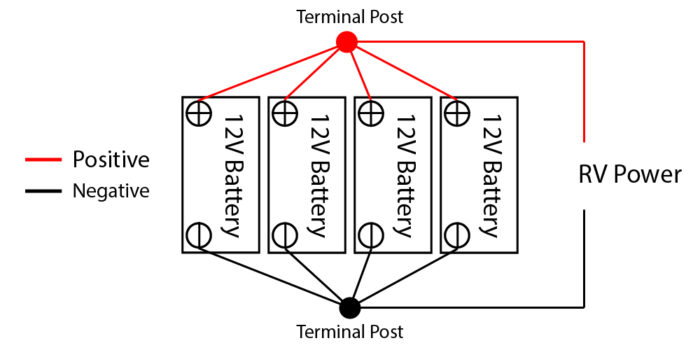
The major downside to this method is not everyone has space in their RV to add external terminal posts.
Also, the difference in balance between this method and others may not be enough to make it worth it.
If you are creating a large solar power bank with 8 or more batteries, apply this method to keep all the batteries healthy.
For small RV battery banks, you can wire in other ways to create balanced batteries.
How To Wire 2 12V Batteries To An RV
Two 12 volt RV batteries wired in parallel is one of the most common set-ups and the one most RV manufacturers add compatments for.
Even my travel trailer came with two deep cycle 12 volt batteries in plastic battery boxes, wired in parallel, and neatly stored on the front of the trailer.
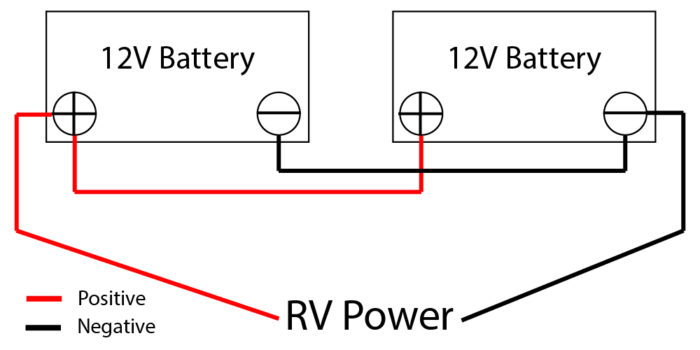
In the graphic above, you see the terminals are wired in parallel using even lengths of cable.
The main difference between this wiring and the one I called wrong is the load wires from the RV are connected to different batteries.
Doing this distributes the load, and with just two batteries, you will have a balanced circuit.
See Also: Power Queen 100Ah Smart Lithium Battery Tested & Reviewed
How To Wire 3 12V Batteries To An RV
Once you add over two batteries, the simple 2 RV battery method gets a little less efficient.
But just adding one more battery will not make a huge difference, so I still suggest wiring a 3 12 volt RV battery setup in a similar way to the 2 battery method.
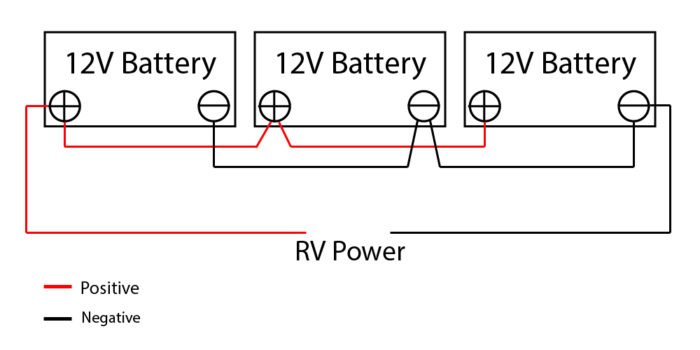
You still need to put the load wires on the end batteries so the middle RV battery is being drawn from evenly.
The middle will put out fewer amps than the end two, but the difference should be small enough that it’s not a huge deal.
If you want three absolutely perfectly balanced RV batteries, you can use the best method I mentioned in the beginning of this section, or apply the Cross-Diagonal method I talk about next.
How To Wire 4 12V Batteries To An RV
If you’re going to add 4 batteries to your RV, you are going to have to get a little fancier with the wiring.
You can still just chain the terminals together like the 2 or 3 battery method, but things will be very unbalanced.
The Cross-Diagonal method is a simple way to keep 4 or more batteries balanced without having to apply the terminal post method seen in Graphic 1.
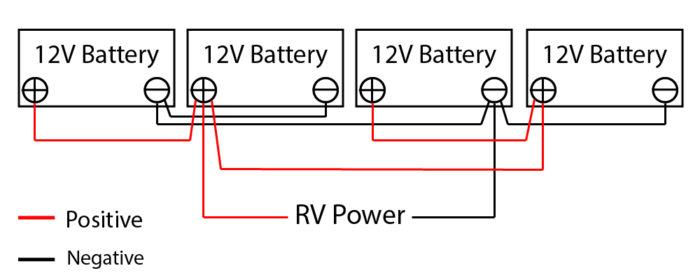
It looks complicated, but if you follow each wire, you will see that it’s easier than it looks.
You can start by connecting two pairs of batteries using a short wire. Then take the two pairs and connect them using one long wire.
This combines the two groups. You connect the RV Power wires to the center terminal that has both the short and long wire on it.
Make sure the negative and positive load wires are still connected to two different batteries.
If everything was wired right, the load wires will connect to the middle batteries.
See Also: Best Portable Solar Panel Charger For RV Camper/Boondocking
Each battery has both a long and short wire connected to it, which helps balance out the resistance, and keeps the 4 batteries even.
By adding a few more connections, it has created a better balance than if you were to use the standard chain connections with the load wires on each end.
If you can’t fit 4 batteries in a row in your RV battery storage space, you can connect them the Cross-Diagonal way in a block, as shown in the graphic below.
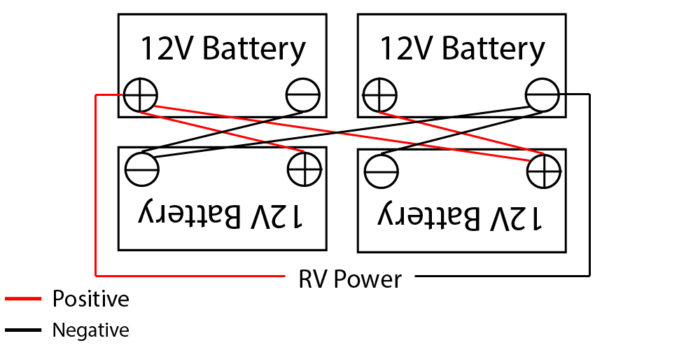
Each battery still has a long and short connecting wire and should still be perfectly balanced.
Right now my travel trailer has 2 12V deep cycle RV batteries sitting on the tongue.
When they finally stop holding a charge, I plan to install 4 12V AGM deep cycle RV batteries like the top choice in this article on the best RV batteries.
After measuring, I found I should be able to fit them all on the trailer tongue like in the graphic below.
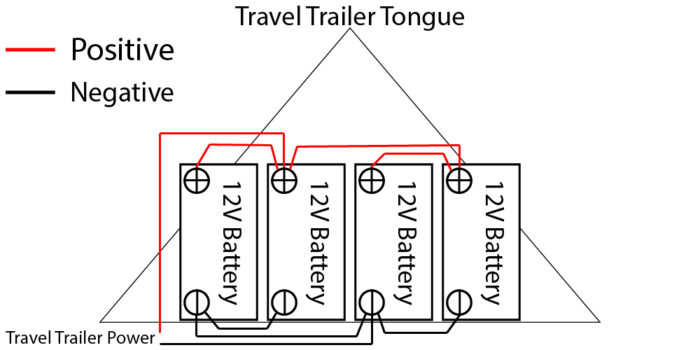
I’ll still be able to use the Cross-Diagonal method to keep the batteries balanced.
The only obstacle is finding a box that can fit all the batteries to keep them protected from the weather.
The reason I want to keep the batteries loaded on the front of the travel trailer is to keep the weight evenly distributed for safer towing.
How To Correctly Wire Multiple 6 Volt Batteries To An RV
6V RV Batteries can be a good choice if you are looking for an increase in durability and total amp hours in a battery.
There are many pros and cons to both 6 and 12 volt batteries for RVing, but it mostly comes down to preference.
You can read more about each kind of RV battery setup and its pros and cons here.
If you’re going with 6 volt RV batteries, the wiring is going to be a little different.
You need to increase the voltage to 12 volts because no RV is made to run on 6 volt power.
You can do this by wiring two 6 volt batteries together in series, which means connecting a positive to a negative terminal.
When you do this, you increase the voltage but not the amperage.
See Also: Best Portable Power Station/Solar Generator For Camping
For example, if you have two 12V 100ah deep cycle RV batteries and you wire them together in parallel, you end up with 12 volts and 200ah.
If you wire two 200ah 6 volt batteries together in series, you end up with 12 volts but the amp hours remain 200.
The good news is you can combine series and parallel wiring with 6 volt batteries so you can combine 4 or more and keep the voltage at 12 for an RV, but increase the amp hours.
I’ll go through each of these wiring methods below.
Note that you should never combine different amp hour 6V batteries. They must be the same size, kind, and, if possible, age.
How To Wire 2 6V Batteries To An RV
As I mentioned before, the first thing you need to do is connect two 6V batteries in series to create a 12 volt battery bank.
You do this with a small piece of wire, preferably the 4 AWG copper wire I mentioned in the 12V section of this article.
The wire color doesn’t matter. I made the series wire blue in the graphics so they are easier to understand.
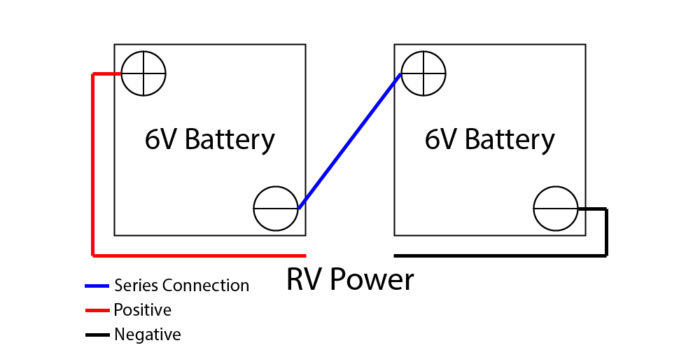
You still attach the load wires that power the RV to different batteries. You should never have both load wires on one 6V battery.
How To Wire 4 6V Batteries To An RV
Once you’ve wired 2 6V batteries in series to make a 12V battery, it’s really easy to wire 2 more 6V batteries together in series and parallel to increase the amp hours.
You can do this by combining each pair of 6V batteries and then wiring them together in parallel like you would 2 12V batteries.
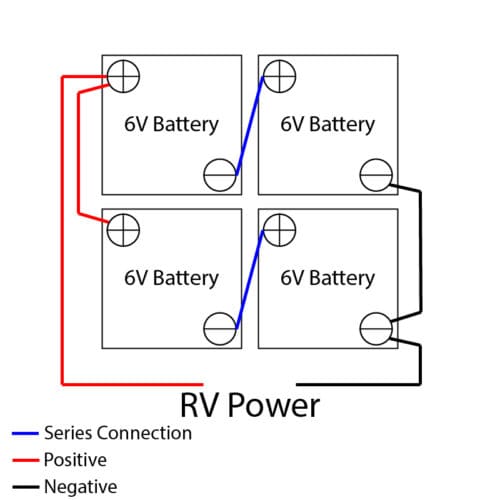
Make sure you connect the load (RV power) wires to the different pairs of 6V batteries, as shown in the graphic above.
This will help keep the batteries balanced, which keeps them healthy and holding a full charge for longer.
See Also: When To Charge A Deep Cycle Battery
How To Wire 6 6V Batteries To An RV
You can make huge battery banks using 6V batteries, but for RV use, even having over 4 6V batteries is going to weigh a lot.
But if your energy needs are high, you can easily wire 6 6V RV batteries together using the same series and parallel method used above.
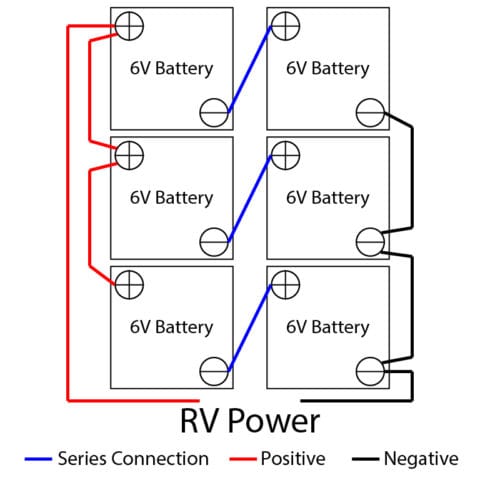
The batteries will be reasonably balanced, much like wiring 3 12V batteries together.
You can use the Cross-Diagonal method to balance them even more if you want, but the difference may not be enough to make it worth it.
How To Wire 8 6V Batteries To An RV
While having 8 6V batteries in an RV isn’t super common, it may be the right choice for you.
I decided to add this diagram to illustrate how 8 6V RV batteries can be wired in series but also balanced in parallel using the Cross-Diagonal method.
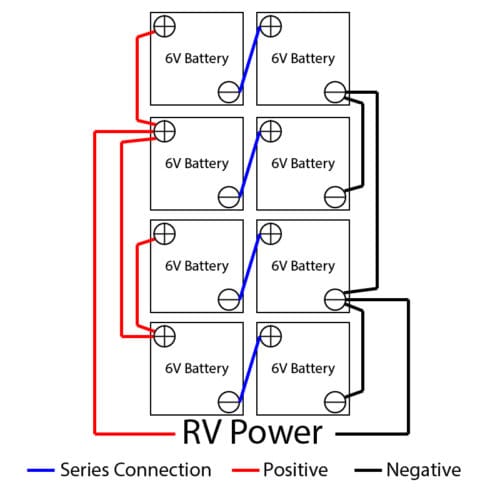
Frequently Asked Questions
What AWG of wire should be used to connect RV batteries?
4 AWG is going to be the best for connecting RV batteries, but you can also use 6 AWG and get good results.
Where do I connect the battery charger on multiple batteries wired together?
The battery charger should always be connected to the same battery terminals the load wires are connected to.
This will help the batteries charge at an even rate so no battery is getting overcharged while another on the same circuit isn’t getting charged enough.
See Also: Best Deep Cycle Battery Chargers Reviewed (12V, 6V, RV, AGM)
Does an RV need 2 batteries?
If you are going to use 6 volt RV batteries, then you have to have at least two of them to reach 12 volts of power.
If you are going to use 12 volt batteries, only one is necessary, but I suggest getting either a large 100ah 12V deep cycle RV battery or two smaller 35-50ah 12V deep cycle RV batteries.
Can you mix batteries with different amp hours (ah)?
When connecting batteries in series as you would with 6V batteries, you cannot mix batteries with different amp hour capacities.
When wiring in parallel, like you would with 12V batteries, you can use different sizes of 12V batteries.
That being said, it’s important to try to not mix different ages of batteries. I wouldn’t wire anything together that are older than 6 months apart.
How do you hook up 3 12V batteries to an RV?
It’s easy to wire 3 12V batteries in parallel to an RV.
You can scroll up and check out the diagram labeled graphic 3 in this article for more information.
Should you leave your RV plugged in all the time?
If you are going to leave your RV plugged in all the time, you should check and make sure your RV has a smart or 3 stage charger installed in the power center (converter area).
Older RVs may only have an older kind of trickle charger in the converter, which can cause your batteries to get overcharged, which can be just as bad for them as going dead.
If your RV has an older charger in it, you can swap it out for a different one pretty easily.
See Also: Should I Disconnect My RV Battery When Plugged In?
If you have a smart or 3 stage charger in your RV, it should be safe to leave the batteries plugged in all the time.
Remember to do regular maintenance on the batteries and check the water levels if they are flooded lead-acid.
Should I wire my RV batteries in series or parallel?
12V RV batteries should always be wired in parallel. You want to keep the voltage the same but increase the amp hours.
6V RV batteries need to be wired in series in pairs to create a 12V battery.
Once two 6V batteries are wired together in series, you can wire them to another pair of 6V batteries using parallel wiring.
What is the difference between RV batteries in series and RV batteries in parallel?
When wiring batteries in series, you are increasing the voltage they will put out.
For example, two 12V batteries wired in series will become a large 24V battery, which is too high for RV use.
That’s why you wire them in parallel instead, because you only want to increase the amp hours, not the voltage.
Because of the increased voltage when wiring batteries in series, you can connect two 6V batteries to create a 12V battery that is compatible with an RV.
Do RV batteries in parallel last longer?
When wired the correct and balanced way, 12V batteries wired in parallel can last a long time.
If they are wired incorrectly, the battery the RV is directly connected to may wear out faster than the others.
It can be slightly harder on batteries to be wired in series, but 6V batteries are known to be tough.
The difference between 2 6V batteries wired in series compared to 2 high quality 12V RV deep cycle batteries wired in parallel will be very small.
Have any more questions about wiring multiple RV batteries? Leave a comment below.


Great article. But I still have a question.
I’ve got Six, 6 volts, series, then parallel. They are brand new, but two are slightly lower in voltage than the other four. I know it’s a warranty issue, but I bought them while travelling and taking them back is not an option.
So, moving forward, is it best to put the two “lower volt” batteries on the outside of the wiring chain?
I have them as you shown in your article, were in my case the two that are connected to RV load in are “First in line”
My after thought is to have them in the middle set wired in series together as they might be causing more resistance the way I have it now.
I value your knowledge. Thank you. Gary
The problem with combining batteries that are different voltages in a battery bank, especially one with 6 batteries, is it can create an unsafe circuit. The larger batteries are going to try and charge the lower voltage ones no matter where they are placed in the circuit, which will result in overcharging and reduce the lifespan of all of the batteries. In a worse case scenario, it could even destroy the smaller voltage batteries.
In large battery banks like yours, it’s even recommended to always use the same brand of batteries as different brands can have slightly different voltages even if the label says they are the same.
Since all the batteries are new I would sell the two odd 6V batteries and buy two new ones that match the other 4 perfectly. Even though you may lose a little money initially your battery bank will be much safer and all the batteries will last longer which saves you money in the long run.
Hello Jenni,
Thank you for your “balanced” 8 6v battery wiring design! Last night I compared all the configurations I could find on the web and agree that your scheme is the most balanced with the fewest resistance creating cables and terminals. I have jumped into the deep end on my RV battery problems as we are moving to more dry camping and less dependency on shoreline power occasions. I have questions that you might help me with and am hoping I’m not in over my head…
I bought 8 6v 225Ah AGMs that I will wire in series-parallel identical to your last figure above. Understanding that all cables and connectors need to be the best quality copper I can find and all of identical length and resistance throughout. I perceive that less is more in terms of gauge? I’ll assume that 2 AWG is overkill and 6 AWG or smaller is just OK or climbing in resistance. Thank you for that recommendation!
On the RV’s Converter/Charger:
But what am I getting into going from 2 “weak” 90Ah (<180Ah total) 12v batteries as the RV with built with when going to 900Ah total in the bank? I will check the converter/charger to make sure it is a “smart charger” type but will I need to modify the converter/charger to accommodate a battery bank 5 times normal capacity? Is there a formula to determine what output my converter/charger should produce to service 900Ah of battery?
On my solar panel charging:
I have been using a 100W solar panel with a 30A charge controller which seemed to do just fine servicing the 2 “weak’ 12V batteries. Will an addition of one more 100W solar panel be sufficient to support a 900Ah bank?
I’m treading in deep water here in terms of understanding… Help!
Thanks again for great info!
KC
You will need to get a different kind of charger that will be capable of handling that amount of amp hours. This Go Power! GPC-100amp 4 stage converter charger (click to view on Amazon) can handle up to 10 batteries and should be able to handle 900Ah. I suggest putting the charger as close to the bank as possible and making sure the wiring is the right size.
That being said I am not a professional and I can only help you with what I know. With a battery bank of that size in an RV I would suggest getting a professional to help you with the charging and wiring aspects. If it’s done right the batteries will last a long time but charging them wrong could ruin them.
As for the solar panels. If you do the math two 100W solar panels will give you about 60Ah per day. At that rate, it would take 15 days to generate 900Ah. Of course, you probably won’t be using that much power daily but you will probably end up wanting more solar panels so you can recharge your power bank quicker.
Jenni,
I have upped my game a bit on the solar panels to service the 900Ah battery bank. Thanks for your help!
In regards to your drawing above, which I intend to use, I have a question with respect to balancing all cables to equalize the resistance so no One battery gets charged any more or less than the others. So does that mean that if the cables that I use to “Bridge” the 2 banks of 4 is 20”, does that mean that the cables that tie them in parallel and the cables that connect in series (blue) all have to be 20”?
Hi KC,
Yes, making all the connecting cables the same length is going to give you the best results.
The 30 amp charger controller is fine for maybe 5 of those tiny panels, so you’re set there. The “converter” should also be fine. It will take more time with any source to charge a much larger bank. The first thing I would do is add panels to the limit of the charge controller, unless it is very limited (PWM), in which case I would change out the entire solar side of it with residential panels and a 60 amp MPPT controller, IF you have the roof space for normal panels. These days, if you buy standard panels, you can get brand name for under 200 bucks with a 400 watt output. If you’re not swapping to LiFePo4, and keeping the same chemistry, you should not need to change anything rlse, but you might want to.
Jenni,
My setup will be the same as “Travel Trailer Tongue” but in a metal, ventilated box behind the steps on my RV.
Would it be advantageous to just flip the second and fourth battery in that diagram so that each cable will be the exact same length when you connect them together in a crosshatch pattern with three “X”s ? If so where would I connect the load cables?
Dave
Hey David,
The cross diagonal method shown on the travel trailer tongue is about the same thing, you just don’t have to run the wires across the tops of the batteries. I think it will work about the same either way. Here’s a diagram with the 2nd and 4th batteries flipped to help show where the load cables should be connected.
Hi Jenni and thank you for such great information. I have two questions if you can please:
We are going for off-grid stays in our van and I will be augmenting the existing 600a of lithium batteries with two additional batteries. They have one season with very few cycles and I have read that in parallel, mixing these with two new is not a concern. Is this ok?
Also, assuming I wire two banks as you have shown for 400a, how should they connect and where should I take 12V power from?
Much appreciated
Hi John,
As batteries are used and age they slowly lose their capacity. When you add a new one to the mix you are basically putting batteries with two different capacities together which is not recommended because either the newer battery will not get charged enough or the older battery will get charged too much which may damage it.
However, if the lithium batteries in your bank have only been used a few times and you have kept them charged with a proper lithium battery charger they probably haven’t lost very much of their original capacity. There will be some difference between the new and old but probably not enough to damage the old batteries when charging. The thing that will most likely happen is the new batteries will lose some capacity a little quicker than they normally would.
I agree that it’s probably not a big concern to add the two new ones.
For your other question about the wiring, are you asking about parallel wiring 4 12V batteries together or 4 6 volt?
Thank you for the response – and I agree. I am trying to fine a diagram for wiring 8-12V batteries in parallel.
Thank you
Sorry Jesse – saw Jenni from a previous post…
Great article – thanks!
I’m in the process of buying a 1999 National Dolphin. For the first 18 months it will be my weekend home on a lot I’ve recently purchased (while my house is being built). Let’s assume that the two 6 volt batteries currently installed are old. In my “perfect world”, I’ve got a 100W solar array that is charging two or four deep cycle batteries that keep me comfortable while I’m there, and then are kept charged during the week by the solar (I have a full south exposure). My questions:
1. do I disconnect the two 6V for now, and just connect the cables to those leads?
2. If I permanently wanted to move over two my new battery array, besides building a stable holder for them, do I need to do anything beyond ensuring that I connect the cables from my new batteries into the existing system? I expect I will be boondocking as I will do some cross country travel during the summer, so the strong battery backup will be of value.
3. Is there any reason to consider doing this with 6V batteries v. 12V?
4. can I have the solar charger connected to the battery array while I’m using the RV?
Thanks in advance for any insights or redirects.
SJ
Hi SJ,
1. Yes, I assume the old 6V batteries are wired in series, if you end up getting 12V batteries you will need to wire them in parallel. Also, never combine old batteries with new ones.
2. No, but again you need to make sure you wire them right. If you go with lithium you will need to make sure you have a lithium compatible charge controller on your RV and solar panel. You can read more about charging lithium batteries in this article here.
3. This is a good question that has a lot to do with personal preference. I have written an article about it you can find here.
4. Yes.
Hope this was helpful, good luck with the RV, if you have any more questions feel free to ask.
Thanks for the quick response – I’ll review the articles you called out!
I want to connect two 12V batteries in series and parallel. Is this possible. This is on my boat so that I can charge the batteries with the 12V charging system from the boat motor and still be able to run my 24V trolling motor.
Hey Marshall,
Connecting your batteries in series for the motor and parallel for the charger won’t work. What you can do is connect a 12V charger to each battery (use 2 12V chargers) or get a 24V battery charger.
I’m in the process of wiring two banks of 6V batteries. Bank 1 is approximately 8 feet from bank 2. What would the recommended gauge wire from the positive terminal on bank 2?
Hi Richard,
The size of wire you need to use depends a lot on how many amps you plan on running from the banks to your RV. If you are connecting them to an inverter you should consult the inverters manual to find out what gauge of wire is recommended.
If the battery bank is just for running the 12V appliances in your RV then something in the 2 to 4 AWG range should work fine.
Keep in mind that I am not a professional and wiring big battery banks like that can be complicated. You may want to consult a professional, especially if you are wiring them to an inverter.
Yes the two battery banks are for running the 12V RV appliances (tv, lights, refrigerator, fans) or through the 300W inverter (tv, laptop, iPhone, etc). Thanks
Jenni, I have installed 4 new/matching 6-V batteries in my RV and have used the most common (included on your site and most others) series/parallel method. Should all hot/ground be connected to one terminal at each end of the battery pack or can I hook to the other end of the hot and ground jumpers?
Hi Oren,
I think that would be possible and it probably won’t unbalance everything too much. It is best to use the outer terminals to connect the hot wires because that’s the most balanced way but if you need to use the opposite ends than what’s shown in the graphic it will probably be fine.
No matter what don’t connect the hot wires on the same end of the battery bank. They need to be as opposite as possible for a balanced charge and output.
Thank You Jenni, I’ll stick to the original layout as that seemed to to be the best alterative, but was just curious. Thanks for your help…
I have a two battery system that I am trying to wire in parallel with 2 more batteries in a separate location 3-4ft away. If the OEM install had two batteries with primary RV Power lines there, what is the best way to wire the 2nd bank of 2 batteries or do i need to move the RV power Negative to the second battery bank? These are all 12volt – Marine batteries.
Hi Scott,
I think the best way is going to be to turn the two battery banks into a large 4 battery bank by moving the negative RV power. For an even draw, you will also need to make sure all the connecting wires are the same length. If there is any way to move the batteries so they can be together that’s going to simplify things a lot.
These are in the bilge of a boat so not possible to move together, but if I extend the negative RV Power, do I need to extend the Positive RV Power line the same, looks like they different in length by a bit already. Should I extend the shortest one? This is house batteries so mostly concerned with Amp hours, but is there a slightly imbalanced approach that will work alternatively? Thank You Jenni!
From what I know about 12 volt battery systems it actually will probably be ok to just extend the negative wire to reach the other group of batteries. There will definitely be a little bit of loss from the long cable but it should still work.
I think the most important thing will be to use thicker wires to connect each pair of batteries so the power draw and battery charge will be as balanced as possible. If you use the cross diagonal method for connecting 4 12V batteries in parallel it should be ok. It’s not an optimal set up with the two pairs being so far apart but hopefully, they will still be fairly balanced.
Makes sense. I will look for a connection block to extend it. Thanks for your help!
Hi Jenni:
Thanks for the informative article. I have an RV that has four 12 V batteries in parallel installed by the manufacturer, but I have space for one more. As it they are getting old, I’m replacing all of the batteries using the original wiring harness, but I’d like to add an additional one. What would be the best way to add the additional battery without having to replace the existing wiring harness. Best as I can tell, the existing batteries are wired per your 4 12v battery diagram.
Thanks again
Hi Carl,
From what I know about wiring batteries, and I’m no professional, it doesn’t seem like it’s possible to add the 5th battery and still use the cross diagonal method. The extra battery just throws everything out of balance.
Even though it will require a little more work, I think using the terminal post method, which is the most balanced, is going to be the best way to go.
I wish I had a better answer but I’ve only ever seen that method used for larger battery banks that use over 4 batteries like the one you want to build.
Hi Jenni:
I might contact a professional, and if I get any more information, I’ll post it here. Thanks again for your help!
Hello,
Great article. I’m about to pick up a 41’ fifth wheel. I’ll be moving in the RV for several months. The lot doesn’t have power right now so I’ll be using a generator.
The RV only has on 12 v battery but I’m considering adding several to create a power bank. I’m still very new to this but I wanted to ask if I have a power bank of 6 batteries, will the generator charge the batteries as is? Or will I need to retrofit some extra equipment to ensure the newly fitted batteries get recharged?
Hopefully that makes sense
Thanks,
RB
Hi RB,
For a battery bank of that size, I would get a second opinion on what size of charger you might need. My knowledge is pretty limited when it comes to banks larger than 4 batteries.
For charging it all depends on how many amp hours each battery has and what rate you want them to be charged at. If we’re talking 6 100 amp hour batteries you will have 600 ah. If you want to charge at a rate of 10% you’re going to need a charger that can output a minimum of 60 amps.
The converter/charger in your RV probably isn’t capable of amperage that high and neither is the wiring. It might be a good idea to get a better charger and wire it close to the battery bank with the recommended size of wire for the amps that will be going through it.
As for the generator, it also depends on what size that is as well.
Help! We have 2 6vt batteries wired in a series as the diagram above. There is no power to my camper or tongue Jack. It has to be a battery issue because when I hook up a single 12 volt everything works fine. The 6 colts are brand new. Thank you.
Hey Lisa,
It sounds like the wiring is the problem. Are you sure the RV negative is on a different battery? Both the RV negative and positive need to be connected to different batteries to make the circuit work.
I can only help as far as the wiring goes. It’s possible that one of the terminals on a battery is bad. The issue with using 6V batteries is everything has to be working and wired properly to run an RV.
Check everything again including the wires that are running between the batteries to connect them in series. If all the wiring looks right then it must be a bad battery.
I need to find out how to connect the power lines and fuse lines to my 4 6volt batteries.
Hi Macy,
If you look at the graphic for how to wire 4 6 volt batteries to an RV it shows you where to connect the positive and negative power lines coming from the RV.
If you want to add a fuse put it on the positive line coming from the RV near the battery. The size of fuse depends on the kind of set up you have but 30 amp fuses are pretty commonly used. I would try and match the amperage coming out of the charger/converter in your camper.
Hi,
Thanks for the great information. I keep my 2005 5th wheel in storage and use at an rv park. So it is plugged in all the time. My heater stopped igniting and I found it might be my batteries causing the problem. I have 2 6v Trojan batteries and I am sure they have gone dead (over 6 years old). After reading your articles, how would I switch over to one 12v DC 75 to 100 ah battery? How does the wiring go?
Thanks for your help,
Steve
Hi Steven,
Because you are using a 12V battery you don’t need to do any fancy wiring. Just connect the positive RV wire to the positive 12V battery terminal and the negative to the negative.
I have a 2020 bullet 30′ trailer and I’d like to add a 3rd 12v battery to the existing 2. Do you think the existing charger/inverter will be adequate to support the 3rd battery?
You have provided great information!! It’s a great service to all of us with RV’s
Rich
I hope you are reading comments still. The 6 -6v example. Why would you not wire 3 in parallel to create effectively 6v with 3xAH then series the two? To create 12v with the same AH. 6-6v220ah would still equal 12v660ah.
Hey David,
I’m going to have to do a little more research on that. The main reason I can see would be just having technically two batteries connected in series would create a very unbalanced battery bank but I’m actually not 100% sure on that. I’m going to contact some people and hopefully get back to you with a good answer soon.
I have 6 12v SOK LFP batteries that I want to hook up in two rows of three. The 4 battery cross connect method seems doable but how do I extrapolate for six vs 4 in the diagram?
Hi Brian,
The cross-connect method is really only good for 4 batteries. A battery bank with 6 batteries is pretty large and I would definitely go with the terminal post method. You can still do two rows of 3 that way and it’s going to be better balanced.
I have two 6 volt batteries wired in a series, can I hook them up to two 12 volt batteries so that I have 3 12 volt batteries?
Hi Bill,
You should never wire batteries that are different voltages together. Even though they are technically the same voltage when wired in series the 6 volt batteries will charge and behave differently than the 12 volt ones.
It’s recommended when building a battery bank to use batteries that are the same voltage, age, and even the same brand.
Hi Jenni,
This article was very informative to me since I am a new RV owner.
I need to store my RV for 5 months and the storage facility does not have 30 or 50 amp service. So, I can’t connect my shoreline power cable. I have a Newmar Class A 2021 model and Newmar does not advise to use a “dogbone” conversion of their shoreline power connector to a standard 110V outlet connector. So, the storage place offers Battery Tenders for my house and chassis battery banks. This is the direction I plan on going.
I liked to be informed, so my question to you is which specific terminals in this 8 battery 6V battery configuration should I connect the Battery Tender positive and negative cables? I have this exact configuration that you have listed below. If you can be specific on the actual diagram that would be ideal, I did not understand your FAQ response. Also, Can you connect 2 battery tenders to this 8 battery 6V configuration, if yes, again what specific terminals would you connect each Battery Tender
Thank you,
Russ
How To Wire 8 6V Batteries To An RV
While having 8 6V batteries in an RV isn’t super common it may be the right choice for you so I thought I’d add this diagram to illustrate how 8 6V RV batteries can be wired in series but also balanced using the Cross-Diagonal method.
Graphic 10
Frequently Asked Questions
Where do I connect the battery charger on multiple batteries wired together?
The battery charger should always be connected to the same battery terminals the load wires are connected to.
This will help the batteries charge at an even rate so no battery is getting overcharged while another on the same circuit isn’t getting charged enough.
Hi Russell,
You connect the cables of the charger to the same terminals the RV power cables are connected to. So put the positive battery charger cable in the same spot as the positive RV power cable and same with the negative.
Some battery chargers can be “stacked” so you have two connected to the same terminals. You will have to read the guidelines for the battery chargers you are going to be using to make sure it’s ok.
I think a good way to keep your battery bank charged with two battery chargers would be to split the banks into two. So rewire them using the 4 6V battery diagram and connect the chargers to the terminals the “RV power” is supposed to be connected to.
Hi Jenni,
Would bus bars work the same as the terminals you mentioned in the section on the 12 volt parallel hook up?
Ray.
Hi Ray,
Yes, bus bars are an excellent way to go.
I just picked up a 3o ft motorhome with 2 12 volt batteries. I have a couple of 12 volt batteries from my boat that I would like to add to my motor home but I should not add it to my existing battery setup because they are different ages. Is it worth setting up a battery switch so I can charge one set and then switch it to the other two when those are complete?
Hi Cliff,
That sounds like a great idea to me, I’ve heard of RVers doing that exact thing.
Here’s a great battery switch (click to view on Amazon) that’s for both RV and marine dual battery bank setups.
Hi. Curious if you can provide a best wiring scenario for 6 x 12v 100 ah renogy agm batteries in parallel.
I am building a custom battery bank in the spare tire area of my class C. I’ll putting 1400w of solar on the roof and a 2000w inverter charger to power both 12v and 120v outlets including the air conditioner with the 600 ah total at 12v. I saw the 4 in your diagram above. They would have that same orientation (3×3) as the 2 x 2 orientation in your 4 battery post.
Happy ton send a photo of it completed! Thanks!
Hi B.B.
For a battery bank of that size, you definitely want to go with the terminal post method with all the connecting cables being the same length.
Sounds like you’re going to have an awesome boonkdocking setup. We’d love it if you’d send some pics of the final result.
I originally found your write-up when I first bought my RV – it only had 2 flooded Lead-Acid batteries from the factory and does have a solar panel for charging. I am going to replace the batteries with 4, and decided to continue with lead acid, because all I want to do is double the over-night battery time – with 2 batteries I get between 6-7 hours, but “need” 10-12 without firing up generator or running my truck to charge. I was planning on the cross-diagonal diagram you provided, but someone with the same RV sent me the diagram as theirs was wired by the factory with 4 batteries. Basically, the batteries are all the same as your diagram, but the charge load from the solar, and the RV Main/Converter and Invertor are separated. That would seem to leave it unbalanced! Your thoughts on this?
Hi Jerry,
I think that could actually work as well. But I’ve always been told to put the load and charging cables on the same terminals since you want the battery that’s being discharged to be charged first.
But since there are two positive and negative terminals that are connected to a long and short wire, putting the RV load wires and solar charge cables in different spots probably won’t unbalance things too much. I think you could go with either way, but I’ve always put the load and solar charge cables on the same termnials.
This seems to only be the case when you use the cross-diagnanol method. Most of the other methods only produce one positive and negative terminal that create a balanced draw so you have to put the RV and solar charging cables on the same terminal.
I’d love to see that diagram if you are willing to email it to me.
Hi Jenni,
Completely brand new to RV’ing. Trying to feel out how much battery life I need. Going to be plugged in the great majority of the time. Family of 6 though with kids and wife that will be using a lot of power on long road trips and when boondocking for 2-3 days max. Bought a brand new Super C with 2 deep cycle 12v batteries and Onan generator. The RV dealer is suggesting I get more batteries and specifically, 4 6v batteries. I read your prior posts that this is not advisable; kind of shocked that they would suggest it then, pretty alarming. Anyway, do you think I need to add an additional 12v or do you think the two 12v’s are enough? Deathly afraid of running out of battery life. Thanks for your help.
Jake
Hi Jacob,
6 volt batteries are still great to use, and back in the day, they were better than 12 volt batteries. But today they are making 12 volt deep cycle batteries that are just as durable. But some still choose 6 volt anyways which is also fine.
If you were to add more 12 volt batteries you would need to buy all new ones since it’s not advisable to have batteries that are different ages in one battery bank.
I think you should go boondocking a few times to see if the two batteries you already have are enough. You will probably need to run your generator for a few hours every day to recharge them.
I also recommend getting some solar panels to charge the batteries during the day as well. The solar panels combined with the generator should keep your RV powered up for a few days of boondocking.
Check out this post for some great solar panel options for charging RV batteries.
After a few camping trips you should know if you will need more battery power or not.
For running the TV and small electronics you could also get a portable power station (click here to read more about them).
They’re better than large battery banks in some ways since they have inverters built in so you can plug AC powered appliances directly into them. They can be charged via solar panels, the generator, and at home.
Welcome to the world of RV’ing!
Great article. I currently have 2 6 volt deep cell batteries. I have 100 watt solar panel. This does not work for us. I just purchased 2, 105 ah lithium batteries. I need to purchase a controller that will work with lithium batteries. I thought it might be good to get a controller that could handle 4 batteries. We dry camp and may need more battery storage. What charge controller should I get. When I switch to the 12 volt batteries, do I connect all the wires that currently are connected to the positive on the 6 volt to the positive of the 12 volt. Then the same with the negative wires? What size controller should get.
Hi,
If the plan is to stick with a single 100W panel, something like the Renogy Voyager 20A (click to view on Amazon) would work with your new batteries. Then you also have the option to buy an additional panel later on.
Are your new batteries 12V? If so, when you switch you’re going to wire the batteries in parallel instead of series. If this is for an RV, the 6V batteries are most likely wired in series right now for a 12V system.
When you wire in parallel, you combine the positives together separate from the negatives. This adds the amperages together, but keeps the voltage the same as from one panel (which is what you want with 12V batteries in a 12V system).
In a series connection, you connect the positive to the negative to combine the volts but not the amps. This is how it’s wired when you use 6V batteries in a 12V system like an RV.
The charge controller I link to can handle 20A, which means 20A from solar panels. A single 100W 12V panel produces about 30Ah on a good day (5-6Ah per hour), so it would take a full week of sunshine to charge your new batteries (210/30).
Therefore I would add a second panel of the same model and wire it in parallel with an MC4 Y branch (click to view on Amazon), before adding more batteries.
Looks like I’ll need 6-8 100 watt solar panels to charge my 12 volt batteries. Would a 60A MPPT controller be able to manage this system? Thanks for you help.
I didn’t mention that I have a 40Amp Intelli Power converter. Model PD 9140 A. How does this play into the picture? Do I need to purchase a charge wizard?
I don’t know enough about the PD converter chargers to say for sure, I recommend contacting them and asking if it’s a good converter for lithium batteries and/or the charge wizard is necessary.
They might recommend a different converter charger, but it’s going to be worth it to upgrade if you’ve spent a lot of money on lithium batteries.
Yes it should, if you look at this Renogy 60A MPPT solar charge controller (click to view on Amazon) for example, it can handle up to 800W at 12V.
Do I hook up any battery cables from my coach batteries to my engine batteries
Hi Tom,
Usually, there aren’t any cables that are connected directly between the coach and engine batteries.
Some RVers will install a charger that is wired from the coach to the engine batteries. If your motorhome has one of these chargers, cables might need to be hooked up to both batteries.
Hi Jenni,
Didn’t see this question asked and maybe because the answer is obvious. I have a 39ft toy hauler with two 12v batteries hooked up in parallel. I have two sets of power cables running to the battery compartment. I assume one is from the 12v converter and the other is from the generator? My question is I assume I hook both sets of cables to the same terminals. Meaning two positives to one battery and two negatives to the other.
Thanks
Bob
Hey Bob,
Yes, you should connect them to the same terminals.
Regarding the section for wiring 3 batteries in parallel, Graphic #3, there is a comment “The middle will put out fewer amps than the end two,” but this comment is not correct. The 3 batteries in this set up are actually equally balanced. Assuming the short connecting wires between the batteries are all the same length and same gauge, then the total resistance in each of the individual battery circuits is identical. Thus, each battery should deliver exactly the same amperage to the load circuit.
For the analysis of this, you can ignore the resistance in the load circuit, but we’ll label it L. If the connecting wires for positive and negative are all the same gauge and length, then assume each connector has identical resistance R.
Total resistance in each individual battery circuit is then:
Batt1 = L +0R(positive) + 2R(negative) = L + 2R
Batt2 = L + 1R(positive) + 1R(negative) = L + 2R
Batt3 – L + 2R(positive) + 0R(negative) = L + 2R
You can see that the middle Batt2 has exactly the same resistance between it and the load circuit, and should therefore deliver exactly the same amperage as the other two.
The Batt3 line has a typo and should read:
Batt3 = L + 2R(positive) + 0R(negative) = L + 2R
It would be good if this article were updated with a disclaimer regarding the recommended wire gauge that one should use, to explain that this recommendation does NOT apply to an RV which includes an inverter to power AC accessories. In this case the wire gauge needs to be significantly larger since the amperage involved will be much higher. For example, for a system which includes a 2000W inverter and 3 batteries in parallel, the wires connecting to the load should be minimum 2/0 (two – ought) gauge and the short connecting wires between the batteries should be a minimum 1/0 gauge. Amperage to drive a 2000W inverter with 90% efficiency could be as high as 172A on the load wires and up to 2/3 of that figure on the short connecting wires (amperage assumes 12.8VDC battery voltage).
Thanks for all the great info Jeff.
I’ve updated the wire size section to recommend 2/0 wire for RV setups with inverters.
Hello. Thank you for the info, I currently have 4, 12v batteries hooked up that mimic your Graphic #5 above. I want to hook another 6 up for a total of 10. would you be able to provide me with an image for that? Thank you again for providing this awesome info.
Hi Justin,
For a battery bank of that size I recommend using the terminal post method in graphic 1.
Regarding your best way to connect multiple batteries in parallel. it seem to me when you use a common terminal for the positives and similarly for the negatives, that those batteries will discharge through the internal resistances of the other batteries.